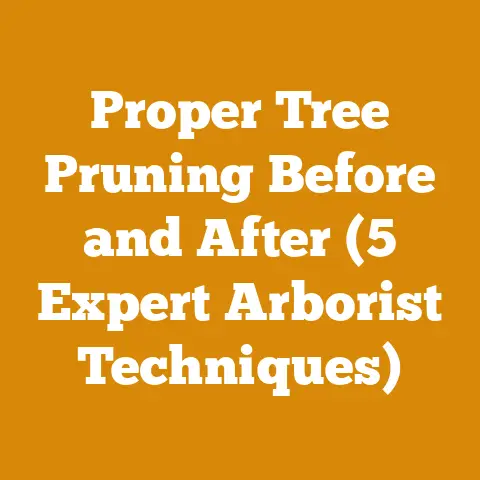Fallen Pine Tree Removal Tips (Pro Chainsaw & Felling Guide)
Fallen Pine Tree Removal Tips (Pro Chainsaw & Felling Guide)
I’ve spent years wrestling with timber in the backwoods, from towering oaks to stubborn pines. There’s a certain satisfaction in turning a fallen giant into manageable firewood, but it’s a task that demands respect and knowledge. Removing a fallen pine, especially, requires careful planning and execution. I’ve seen firsthand what happens when shortcuts are taken. This guide is designed to share that experience, turning hard-won lessons into practical advice for you.
Assessing the Situation: A Crucial First Step
Before even thinking about firing up the chainsaw, take a good, long look at the fallen pine. This assessment is critical for planning a safe and efficient removal.
Evaluating the Risks
First, identify potential hazards. Is the tree tangled in power lines? If so, do not attempt to remove it yourself. Contact your local utility company immediately. Are there branches under tension? These can spring back with tremendous force when cut. Is the tree lying on a slope, increasing the risk of rolling?
I remember one time I rushed into a fallen tree removal without properly assessing the tension. A branch snapped back and nearly took my leg out. It was a painful reminder that patience and observation are paramount.
Consider the following:
- Power Lines: Stay at least 50 feet away and call the utility company.
- Tension: Look for bent or compressed branches indicating stored energy.
- Slope: Be aware of the potential for the tree to roll downhill.
- Snags: Broken or hanging branches that could fall unexpectedly.
- Surrounding Environment: Note any obstacles like fences, buildings, or other trees.
Planning Your Approach
Once you’ve identified the risks, formulate a plan. This includes determining the order in which you’ll cut the tree, where you’ll pile the wood, and how you’ll deal with any obstacles.
Think about the weight distribution of the tree. Where is it likely to shift when you make cuts? Use this information to plan cuts that minimize the risk of binding or pinching your chainsaw.
Consider the size of the tree and the equipment you have available. Are you equipped to handle large sections of trunk? Or will you need to cut the tree into smaller, more manageable pieces?
Essential Tools and Safety Gear
No fallen tree removal is complete without the right tools. Here’s a list of what I consider essential:
- Chainsaw: Choose a chainsaw appropriate for the size of the tree. A 16-20 inch bar is generally sufficient for most fallen pines.
- Chainsaw Safety Gear:
- Helmet: Protects your head from falling debris.
- Eye Protection: Safety glasses or a face shield are crucial.
- Hearing Protection: Chainsaws are loud; protect your hearing.
- Chainsaw Chaps: These provide crucial protection for your legs.
- Gloves: Improve grip and protect your hands.
- Steel-Toed Boots: Protect your feet from injury.
- Wedges: Plastic or aluminum wedges help prevent the saw from binding in the cut.
- Sledgehammer or Maul: Used to drive wedges.
- Axe or Hatchet: For limbing and clearing brush.
- Cant Hook or Peavey: For rolling logs.
- Measuring Tape: For measuring cut lengths.
- First-Aid Kit: In case of minor injuries.
- Cell Phone: For emergencies.
Tool Maintenance:
- Chainsaw Sharpness: A sharp chain is crucial for safety and efficiency. Sharpen your chain regularly.
- Chain Oil: Keep the chain oil reservoir full to lubricate the chain and bar.
- Fuel: Use fresh fuel mixed to the correct ratio.
- Tool Inspection: Inspect all tools before each use for damage or wear.
Takeaway: A thorough assessment and proper preparation are the foundations of safe and efficient fallen pine removal. Don’t skip this step!
Chainsaw Techniques for Fallen Trees: Mastering the Cuts
Once you’ve assessed the situation and gathered your tools, it’s time to start cutting. Here’s where knowing your chainsaw techniques becomes critical.
Understanding Compression and Tension
Before making any cuts, understand the concepts of compression and tension. These forces determine how the wood will react when cut and are crucial for preventing the saw from binding.
- Compression: The wood is being squeezed together. Cutting on the compression side will cause the kerf (the cut opening) to close.
- Tension: The wood is being pulled apart. Cutting on the tension side will cause the kerf to open.
Identifying these forces is key to making safe and controlled cuts.
Limbing Techniques
Limbing involves removing the branches from the trunk. Here are some tips:
- Work from the Base Up: Start at the base of the tree and work your way up. This reduces the risk of branches falling on you.
- Cut on the Outside of the Branch: Cut on the side of the branch away from the trunk. This prevents the branch from pinching the saw.
- Support the Branch: If the branch is large, support it with your hand or foot while cutting. This prevents it from snapping unexpectedly.
- Be Aware of Spring Poles: Small, bent branches can spring back when cut. Exercise caution when limbing these.
I’ve found that a sharp axe can be just as effective as a chainsaw for limbing smaller branches. It’s quieter and often faster.
Bucking Techniques: Cutting the Trunk
Bucking is the process of cutting the trunk into manageable lengths. This is where understanding compression and tension is most important.
- Top Bind: The log is supported at both ends, and the top is in compression.
- Solution: Make a cut one-third of the way through from the top, then finish the cut from the bottom, slightly overlapping the first cut.
- Bottom Bind: The log is supported in the middle, and the bottom is in compression.
- Solution: Make a cut one-third of the way through from the bottom, then finish the cut from the top, slightly overlapping the first cut.
- Side Bind: The log is twisted, causing compression on one side.
- Solution: Use wedges to open the kerf and prevent the saw from binding.
The Importance of Wedges:
Wedges are your best friend when bucking logs. They prevent the saw from binding and help control the direction of the fall. Drive wedges into the kerf behind the saw as you cut, especially when dealing with logs under tension or compression.
I always carry a variety of wedges – plastic for general use and aluminum for when I need extra force.
Dealing with a Tree on a Slope
Removing a fallen tree on a slope adds another layer of complexity. The risk of the tree rolling downhill is significant.
- Cut from the Upslope Side: Position yourself on the upslope side of the tree to avoid being caught if it rolls.
- Use Wedges to Control the Roll: Drive wedges into the kerf to control the direction of the roll.
- Cut in Short Sections: Cut the tree into shorter sections to reduce the weight and momentum if it starts to roll.
- Secure the Tree: If possible, use ropes or chains to secure the tree to a stable object uphill.
Felling Techniques (If Necessary)
Sometimes, a fallen tree is partially supported by another tree, requiring you to fell the supporting tree to safely remove the fallen one. This is a complex and dangerous task that should only be attempted by experienced individuals.
- Assess the Lean: Determine the direction the tree will fall naturally.
- Plan Your Escape Route: Clear a path away from the tree at a 45-degree angle to the direction of fall.
- Make a Notch: Cut a notch on the side of the tree facing the direction you want it to fall. The notch should be about one-third of the tree’s diameter.
- Make a Back Cut: Cut from the opposite side of the tree, slightly above the notch. Leave a hinge of uncut wood to control the fall.
- Use Wedges: Drive wedges into the back cut to help direct the fall.
- Yell “Timber!”: Warn anyone in the area before the tree falls.
- Retreat Quickly: Move away from the falling tree along your escape route.
Important Note: Felling trees is inherently dangerous. If you are not experienced, hire a professional arborist.
Takeaway: Mastering chainsaw techniques and understanding the forces at play are essential for safe and efficient fallen tree removal. Always prioritize safety and never hesitate to seek professional help if you’re unsure.
Safety First: Minimizing Risks and Preventing Accidents
Removing a fallen tree is inherently dangerous. It’s crucial to prioritize safety at every step of the process. I’ve seen too many accidents in the woods to take safety lightly.
Personal Protective Equipment (PPE)
I can’t stress this enough: always wear appropriate PPE. This includes:
- Helmet: Protects your head from falling debris.
- Eye Protection: Safety glasses or a face shield are crucial to prevent eye injuries.
- Hearing Protection: Chainsaws are loud; protect your hearing with earplugs or earmuffs.
- Chainsaw Chaps: These provide crucial protection for your legs.
- Gloves: Improve grip and protect your hands from cuts and abrasions.
- Steel-Toed Boots: Protect your feet from injury.
Safe Chainsaw Operation
- Read the Manual: Familiarize yourself with your chainsaw’s operating instructions.
- Start the Chainsaw on the Ground: Place the chainsaw on the ground and start it with your foot firmly planted on the rear handle.
- Maintain a Firm Grip: Use both hands to grip the chainsaw firmly.
- Keep Your Balance: Maintain a stable stance and avoid overreaching.
- Don’t Cut Above Shoulder Height: Cutting above shoulder height is dangerous and can lead to loss of control.
- Be Aware of Kickback: Kickback occurs when the tip of the chainsaw bar contacts an object, causing the saw to jump back towards the operator. Avoid using the tip of the bar and be prepared for kickback.
- Never Work Alone: Always have someone nearby in case of an emergency.
- Take Breaks: Chainsaw work is physically demanding. Take frequent breaks to avoid fatigue.
- Stay Sober: Never operate a chainsaw under the influence of alcohol or drugs.
Assessing and Mitigating Hazards
- Power Lines: Stay at least 50 feet away from power lines and call the utility company if a tree is tangled in them.
- Tension: Be extremely careful when cutting branches or logs under tension. These can spring back with tremendous force.
- Slope: Be aware of the potential for the tree to roll downhill.
- Snags: Broken or hanging branches can fall unexpectedly.
- Wildlife: Be aware of the presence of wildlife, such as snakes, insects, and rodents.
Emergency Preparedness
- First-Aid Kit: Keep a well-stocked first-aid kit readily available.
- Cell Phone: Carry a cell phone with you in case of an emergency.
- Emergency Plan: Have a plan in place for dealing with emergencies, such as injuries or equipment failures.
- Know Your Location: Be able to provide your exact location to emergency responders.
I always carry a whistle in my pocket. It’s a simple but effective way to signal for help if I’m injured and can’t reach my phone.
Common Mistakes to Avoid
- Rushing: Don’t rush the job. Take your time and plan each cut carefully.
- Overconfidence: Don’t overestimate your abilities. If you’re unsure about something, seek professional help.
- Ignoring Warning Signs: Pay attention to warning signs, such as unusual noises or movements.
- Using Dull Equipment: A dull chainsaw is more dangerous than a sharp one. Keep your chain sharp.
- Poor Communication: If working with others, communicate clearly and frequently.
Takeaway: Safety should always be your top priority when removing a fallen tree. By following these guidelines, you can minimize risks and prevent accidents.
Wood Utilization: Turning Fallen Pine into Valuable Resources
Once the fallen pine is removed, you’re left with a valuable resource: wood. Pine is a versatile wood with many uses.
Firewood Preparation
Pine makes decent firewood, although it burns faster than hardwoods like oak or maple. It’s best suited for shoulder season fires or kindling.
- Splitting: Pine splits relatively easily. Use a maul or log splitter to split the wood into manageable pieces.
- Drying: Pine needs to be dried properly before burning. Stack the wood in a well-ventilated area for at least six months, preferably longer.
- Moisture Content: Aim for a moisture content of 20% or less before burning. Use a moisture meter to check the moisture content.
- Stacking: Stack the wood neatly to promote air circulation and drying.
I prefer to mix pine firewood with hardwoods for a more balanced burn. The pine gets the fire going quickly, and the hardwoods provide long-lasting heat.
Lumber and Milling
Pine can be milled into lumber for various construction and woodworking projects.
- Sawing: Use a chainsaw mill or a portable sawmill to cut the logs into lumber.
- Grading: Grade the lumber according to industry standards.
- Drying: Dry the lumber properly to prevent warping and cracking.
- Uses: Pine lumber can be used for framing, sheathing, siding, and trim.
I once built a small shed entirely from pine lumber milled from fallen trees on my property. It was a rewarding experience and a great way to utilize a natural resource.
Other Uses
Pine has other uses as well:
- Mulch: Pine needles make excellent mulch for gardens.
- Compost: Pine shavings and sawdust can be added to compost piles.
- Crafts: Pine cones and branches can be used for crafts and decorations.
Sustainable Practices
When utilizing fallen pine, consider sustainable practices:
- Leave Some Wood for Wildlife: Leave some logs and branches on the ground to provide habitat for wildlife.
- Replant Trees: If possible, replant trees to replace the ones that were removed.
- Minimize Waste: Utilize as much of the wood as possible.
Takeaway: Fallen pine can be a valuable resource. By utilizing it wisely, you can reduce waste and benefit from its many uses.
Environmental Considerations: Minimizing Impact and Promoting Sustainability
Removing a fallen pine tree inevitably has an impact on the environment. It’s important to minimize that impact and promote sustainability.
Soil Erosion
Removing a fallen tree can disturb the soil and increase the risk of erosion.
- Minimize Disturbance: Avoid unnecessary soil disturbance during the removal process.
- Revegetate Disturbed Areas: Plant grass or other vegetation on disturbed areas to stabilize the soil.
- Use Erosion Control Measures: Use erosion control measures, such as silt fences or straw bales, to prevent soil from washing away.
Wildlife Habitat
Fallen trees provide habitat for wildlife.
- Leave Some Wood for Wildlife: Leave some logs and branches on the ground to provide habitat for wildlife.
- Avoid Disturbing Nesting Sites: Avoid disturbing nesting sites during the removal process.
- Protect Water Quality: Prevent sediment and debris from entering streams or other bodies of water.
Water Quality
Removing a fallen tree near a stream or other body of water can negatively impact water quality.
- Avoid Working in Water: Avoid working directly in the water if possible.
- Use Sediment Control Measures: Use sediment control measures to prevent sediment from entering the water.
- Protect Riparian Areas: Protect riparian areas (the areas along the banks of streams) from disturbance.
Forest Health
Removing a fallen tree can impact forest health.
- Remove Diseased Trees: Remove any diseased trees to prevent the spread of disease.
- Promote Biodiversity: Encourage a diversity of tree species in the forest.
- Replant Trees: Replant trees to replace the ones that were removed.
Responsible Disposal
Dispose of any waste materials responsibly.
- Recycle: Recycle any recyclable materials, such as metal or plastic.
- Compost: Compost any organic materials, such as leaves or branches.
- Dispose of Waste Properly: Dispose of any remaining waste materials properly.
Regulations and Permits
Be aware of any local regulations or permit requirements related to tree removal.
- Check with Local Authorities: Check with your local authorities to determine if any permits are required.
- Follow Regulations: Follow all applicable regulations.
Takeaway: By considering the environmental impacts of fallen tree removal and implementing sustainable practices, you can minimize your impact on the environment and promote forest health.
Advanced Techniques and Considerations
For those with more experience or more complex situations, here are some advanced techniques and considerations.
Using a Winch
A winch can be a valuable tool for moving large logs or pulling a fallen tree away from obstacles.
- Choose the Right Winch: Select a winch with sufficient capacity for the job.
- Use Proper Rigging: Use proper rigging techniques to ensure safety.
- Anchor the Winch Securely: Anchor the winch to a stable object, such as another tree or a vehicle.
- Operate the Winch Safely: Follow the winch manufacturer’s instructions and operate the winch safely.
Working with Heavy Equipment
If you have access to heavy equipment, such as a skid steer or a tractor, you can use it to move logs and clear debris.
- Operate Equipment Safely: Operate the equipment safely and follow the manufacturer’s instructions.
- Be Aware of Surroundings: Be aware of your surroundings and avoid hitting obstacles.
- Use Proper Lifting Techniques: Use proper lifting techniques to avoid damaging the equipment or injuring yourself.
Dealing with Hazardous Trees
Some fallen trees may be hazardous due to disease, decay, or structural instability.
- Assess the Risk: Assess the risk carefully before attempting to remove a hazardous tree.
- Use Specialized Techniques: Use specialized techniques, such as rigging or controlled felling, to remove the tree safely.
- Seek Professional Help: If you are not experienced in dealing with hazardous trees, seek professional help.
Salvage Logging
Salvage logging involves harvesting trees that have been damaged by fire, insects, or disease.
- Follow Best Management Practices: Follow best management practices to minimize environmental impacts.
- Obtain Necessary Permits: Obtain any necessary permits before starting salvage logging operations.
- Work with a Forester: Work with a forester to ensure that the salvage logging is done sustainably.
Timber Grading and Value
If you plan to sell the lumber from the fallen pine, it’s important to understand timber grading and value.
- Learn Timber Grading Rules: Learn the timber grading rules for your region.
- Grade the Lumber Carefully: Grade the lumber carefully to determine its value.
- Market Your Lumber Effectively: Market your lumber effectively to get the best price.
Takeaway: These advanced techniques and considerations can help you tackle more complex fallen tree removal projects and maximize the value of the wood. However, it’s important to have the necessary experience and training before attempting these techniques.
Removing a fallen pine tree is a challenging but rewarding task. By following these tips and prioritizing safety, you can safely and efficiently remove the tree and utilize the wood for various purposes. Remember to always assess the situation, plan your approach, and use the right tools and techniques. And never hesitate to seek professional help if you’re unsure about something. The woods can be unforgiving, but with knowledge and respect, you can navigate them safely and productively.






